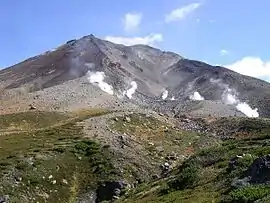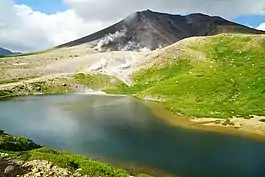Asahi-dake
Mount Asahi (旭岳, Asahi-dake) is a mountain located near the town of Higashikawa, Hokkaido and the tallest mountain on the Japanese island of Hokkaido. It is part of the Daisetsuzan Volcanic Group of the Ishikari Mountains, it is located in the northern part of the Daisetsuzan National Park.
| Mount Asahi | |
|---|---|
| 旭岳 | |
 Mount Asahi, the tallest peak in Hokkaidō (September 2004) | |
| Highest point | |
| Elevation | 2,290.9 m (7,516 ft) [1] |
| Prominence | 2,290.9 m (7,516 ft) |
| Listing | List of mountains and hills of Japan by height List of ultra prominent peaks List of volcanoes in Japan |
| Coordinates | 43°39′N 142°51′E |
| Naming | |
| Language of name | Japanese |
| Geography | |
 Mount Asahi Location of Mount Asahi in Japan. | |
| Location | Higashikawa, Hokkaido, Japan |
| Parent range | Daisetsuzan Volcanic Group |
| Topo map | Geographical Survey Institute 25000:1 旭岳 25000:1 愛山溪温泉 50000:1 大雪山 50000:1 旭岳 |
| Geology | |
| Age of rock | Holocene[2] |
| Mountain type | Stratovolcano[3] |
| Last eruption | 1739 |

The mountain is popular with hikers in the summer and can be easily reached from Asahidake Onsen via Asahidake Ropeway. During winter, the mountain is open for use by skiers and snowboarders.
Sugatami Pond, directly below the peak, is famous for its reflection of the peaks, snow, and steam escaping from the volcanic vents.
Geology
Mount Asahi is an active stratovolcano, 2,291 metres (7,516 ft) in height[3] that arose 3 kilometres (1.9 mi) southwest of the Ohachi-Daira caldera.[3] The Japan Meteorological Agency gave the region rank C[4] in volcanic activity. The volcano consists mainly of andesite and dacite,[4] Holocene volcanic non-alkali mafic rock less than 18,000 years old.[2] In addition to the main peak, there is a smaller volcano emerging from the southeast shoulder of the mountain, Mount Ushiro Asahi or Rear Mount Asahi (後旭岳, Ushiro-Asahi-dake).
Eruptive history
There is no historical record of the eruptions of Mount Asahi. Tephrochronology and radiocarbon dating have determined the following events:[3]
- 3200 BC ± 75 years, Asahi Soria deposit, corrected radiocarbon dating, explosive eruption
- 2800 BC ± 100 years, As-A tephra, corrected radiocarbon dating, explosive eruption and phreatic explosions
- 1450 BC ± 50 years, As-B tephra, uncorrected radiocarbon dating, explosive eruption and phreatic explosions
- 500 BC ± 50 years, Ash-b tephra, tephrochonology, explosive eruption and phreatic explosions and debris avalanches
- 1739, tephrochronology, explosive eruption and phreatic explosions with possible eruption of the central vent and radial good
Mount Asahi currently exhibits steam activity in the form of fumaroles.[4]
References
- Geological Survey Institute topographic map Asahi-dake 旭岳
- "Seamless Digital Geological Map of Japan". Geological Survey of Japan. Advanced Industrial Science and Technology. 2007. Retrieved 2008-07-09.
- "Daisetsu". Global Volcanism Program. Smithsonian Institution. Retrieved 2008-07-09.
- "Quaternary Volcanoes in Japan". Geological Survey of Japan. National Institute of Advanced Industrial Science and Technology (AIST). 2006. Archived from the original on 2008-03-22. Retrieved 2008-07-09.
- "Asahi-dake, Japan". Peakbagger.com.
- Watanabe, Teiji and Hauser, Markus. ASAHI-DAKE: The heart of the Daisetsuzan National Park. Hiking map 1:25,000. Alice Inc. (2017) ISBN 4906740278